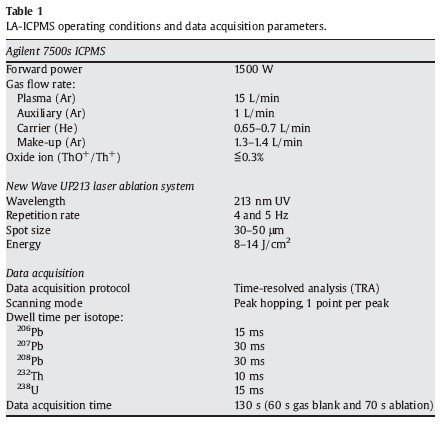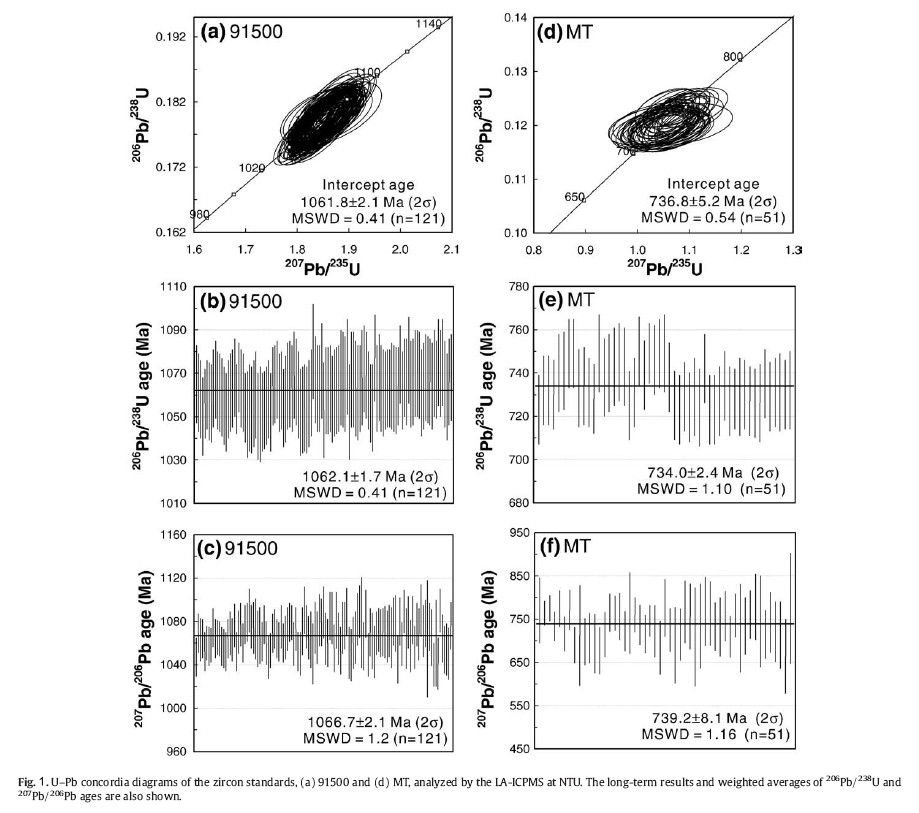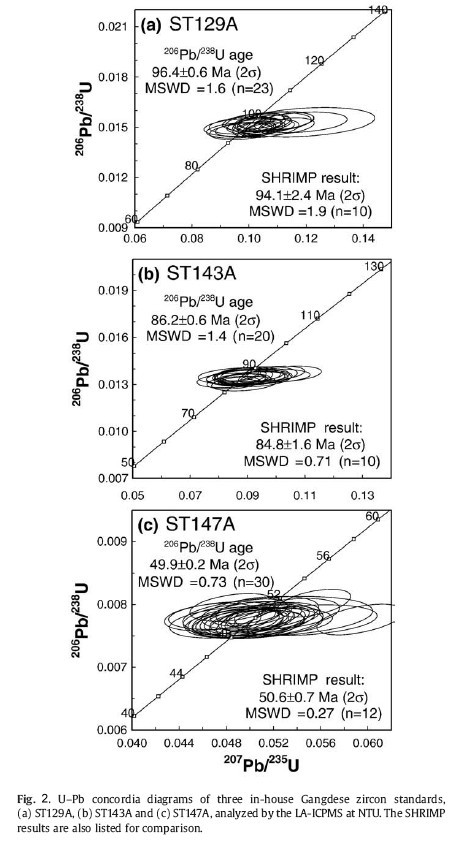![]() Zircon U–Pb geochronology
Zircon U–Pb geochronology
Zircon U–Pb isotopic analyses were performed using
the laser ablation-inductively coupled plasma–mass spectrometry
(LA-ICPMS), using an Agilent 7500s quadrupole ICPMS and a
NewWave UP213 laser ablation system housed at NTU. The operating
conditions and data acquisition parameters are summarized in Table 1.The laser ablation was performed with a helium carrier gas that
can substantially reduce the deposition of ablated material onto the sample surface and greatly improve transport efficiency, and thus
increase the signal intensities, as compared to “conventional” ablation using argon as the carrier gas (Eggins et al., 1998; Günther and
Heinrich, 1999; Jackson et al., 2004). During the experiments, about 1 min was spent for measuring gas blank and the results indicate
sensitivities of less than 1000 counts per second (cps) for all measured
isotopes. Calibration was performed using the GJ-1 zircon standard
(provided by the Australian Research Council National Key Centre for
Geochemical Evolution and Metallogeny of Continents, at Macquarie University, Sydney), well established for a precise 207Pb/206Pb age and
an intercept age using isotope-dilution thermal ionization mass
spectrometry (ID-TIMS) at 608.5±0.4 Ma (2σ) and 608.5±1.5 Ma
(2σ), respectively (Jackson et al., 2004). The Harvard reference zircon
91500 and Australian Mud Tank Carbonatite zircon (MT) were used as secondary standards for data quality control. All U–Th–Pb isotope ratios were calculated using the GLITTER 4.0 (GEMOC) software, and
common lead was corrected using the common lead correction function proposed by Anderson (2002). The weighted mean U–Pb ages and concordia plots were carried out using Isoplot v. 3.0 (Ludwig,
2003).

Our LA-ICPMS results for the secondary zircon standards 91500 and
MT, obtained during April 2006 and October 2007, are shown in the
concordia diagrams (Fig. 1). The intercept, 206Pb/238U and 207Pb/206Pb
ages of zircon 91500 are 1061.8±2.1 Ma (2σ), 1062.1±1.7 Ma (2σ)
and 1066.7±2.1 Ma (2σ), respectively (Fig. 1a–c), which are in perfect
accordance with the consensus results reported by Wiendenbeck et al.
(1995) using ID-TIMS method that gave 207Pb/206Pb age at 1065.4±
0.6 Ma (2σ) and 206Pb/238U age at 1062.4±0.8 Ma(2σ). The intercept,
206Pb/238U and 207Pb/206Pb ages of zircon MTare 736.8±5.2 Ma (2σ),
734.0±2.4 Ma (2σ) and 739.2±8.1 Ma (2σ), respectively (Fig. 1d–f),
also well match the U–Pb concordia intercept age of 732±5 Ma
reported by Black and Gulson (1978) using ID-TIMS method.
Additionally, before starting routine U–Pb dating analysis, we
established three “in-house” secondary zircons, which are igneous
zircons separated from three Gangdese I-type granites, samples
ST129A, ST143A and ST147A, whose 206Pb/238U ages have been
measured using the SHRIMP method that gave 94.1±2.4 Ma (2σ),
84.8±1.6 Ma (2σ) and 50.6±0.7 Ma (2σ), respectively (Wen et al.,
2008a). Our LA-ICPMS results of 206Pb/238U ages of these three inhouse
zircon standards are 96.4±0.6 Ma (2σ), 86.2±0.6 Ma (2σ) and
49.9±0.2 Ma (2σ), respectively (Fig. 2), which are all in good
consistency with the SHRIMP results.

